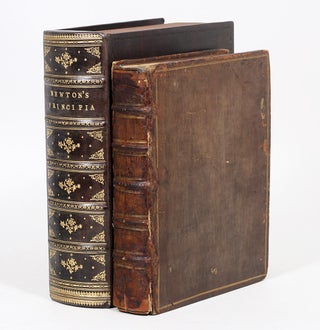Philosophiae Naturalis Principia Mathematica
RARE 1726 THIRD EDITION OF NEWTON'S PRINCIPIA, THE LAST EDITION EDITED BY NEWTON AND THE BASIS FOR ALL SUBSEQUENT EDITIONS. One of only 1250 copies printed.
"The Principia is generally described as the greatest work in the history of science. Copernicus, Galileo and Kepler had certainly shown the way; but where they described the phenomena they observed, Newton explained the underlying universal laws. The Principia provided the great synthesis of the cosmos, proving finally its physical unity. Newton showed that the important and dramatic aspects of nature that were subject to the universal law of gravitation could be explained, in mathematical terms, within a single physical theory. With him the separation of natural and supernatural, of sublunar and superlunar worlds disappeared. The same laws of gravitation and motion rule everywhere; for the first time a single mathematical law could explain the motion of objects on earth as well as the phenomena of the heavens. The whole cosmos is composed of inter-connecting parts influencing each other according to these laws. It was this grand conception that produced a general revolution in human thought, equalled perhaps only by that following Darwin's Origin of Species. It was the final, irrevocable break with a medieval conception based on Greek and Roman cosmology and a scholastic system derived from the medieval interpretation of Aristotle... Newton's universe, almost independent of the spiritual order, ushered in the age of rationalism, scientific determinism and the acceptance of a mechanistic view of nature" (Printing and the Mind of Man 161).
On the history and importance of the third edition:
Towards the end of his life, Newton "gave one last effort to the Principia. It is clear that he regarded the Principia rather than the Opticks as his masterwork... He worked over the Principia without end to hone its language to a perfect expression of his ideas. Perhaps the appearance of a reprint of the second edition in Amsterdam in 1723 stimulated Newton to put his plan for a new edition into action. Perhaps a serious illness in 1722 reminded him that he could not delay forever. We know only that printing of an edition more sumptuous than either of the others began in the fall of 1723. As editor, Newton had the services of a young member of the Royal Society, Henry Pemberton... In the fall of 1723, Pemberton addressed to him the first of thirty-one communications which stretched over the following two-and-a-half years while the edition passed through the press... Through 1724 and 1725 the edition made its slow but steady progress toward completion with none of the delays that stopped the press during the second edition. Newton dated the preface 12 January 1726. It was the last day of March when Martin Folkes presented a copy 'richly Bound in morocco Leather' to the Royal Society in Newton's name. In all, 1,250 copies were printed..." (Westfall, The Life of Isaac Newton).
Provenance:
With engraved bookplate of Jeremiah Dixon, almost certainly the Jeremiah Dixon of “Mason-Dixon” fame. Dixon (1733-1777) studied astronomy and mathematics and was a Fellow of the Royal Society before coming to America with Charles Mason to perform the surveying work that would later be known as the “Mason-Dixon” line. Also with small discreet circular stamp on title verso and H2 for the Selbourne Library, the library of the noted twentieth-century book collector Hugh Selbourne.
With frontispiece portrait engraving by Vertue and numerous illustrations in text. Complete with the privilege leaf, half-title, dedication leaf, index and ad leaf. London: Guil. & Joh. Innys, Regiae Societatis typographos, 1726. Quarto, contemporary calf. Housed in a spectacular custom full calf box with built-in display cradle. Nearly invisible repairs to joints; flyleaf re-attached. Binding with general scuffing (particularly to spine) and exposure at joints. Joints tender, but holding. Text extremely clean. A handsome copy, rare in contemporary calf.
Check Availability:
P: 212.326.8907
E: michael@manhattanrarebooks.com


